Bikur Cholim Hospital
Bikur Cholim Hospital (Hebrew: בית החולים ביקור חולים) is a 200-bed general hospital in Jerusalem, Israel established in the 19th century.[1] It is the oldest hospital in the country.
| Bikur Cholim Hospital | |
|---|---|
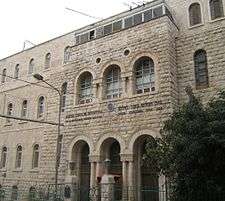 Bikur Holim Hospital in downtown Jerusalem | |
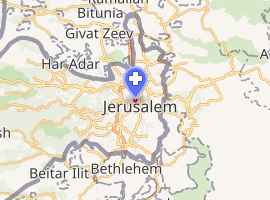
| |
| Geography | |
| Location | Jerusalem, Israel |
| Organisation | |
| Type | General hospital |
| Affiliated university | Hebrew University of Jerusalem |
| Network | Shaare Zedek Medical Center |
| Services | |
| Emergency department | yes |
| Beds | 200 |
| History | |
| Opened | 1826 |
| Links | |
| Lists | Hospitals in Israel |
Bikur Cholim is known for its obstetrics and cardiac departments. The hospital also operates a modern neonatal intensive care unit, a pediatrics department, and bariatric and plastic surgery units.[2] Bikur Holim treats some 60,000 patients annually. With 700 administrators, doctors, nurses, technicians and cleaners, it is one of Jerusalem's largest downtown employers. One-third of the doctors are Israeli Arabs, many of whom choose Bikur Holim for their residencies.[3]
As of December 2012 the hospital has been taken over by Shaare Zedek Medical Center and will continue to function as a branch of Shaare Zedek.
History
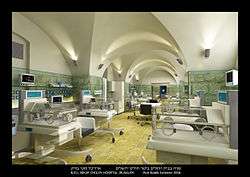
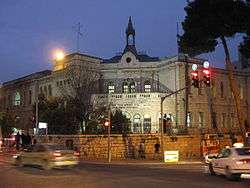
Bikur Cholim opened in a rented building in the Old City around 1826. In 1843, it had three rooms for patients. It was run by the Bikur Cholim society. After the Mission established a medical facility in the Old City, hoping to attract Jews, the society intensified its activity.[4] In 1854, a building was purchased which soon grew overcrowded. In 1864, another complex of buildings was acquired incorporating treatment rooms, a pharmacy, a hospice for the terminally ill and administrative offices. The Ashkenazi Perushim Hospital, as it was known, became the favorite charity of the British Jewish philanthropist Moses Montefiore, who described the facility in his diary in 1875. The general ward consisted of two rooms, each with eight beds. One room was reserved for men, and the other for women. In 1893, the hospital cared for 781 patients and treated 12,347 people in its out-patient clinics.[5] In 1898, during his visit to Jerusalem, German emperor Wilhelm II donated a large amount of money used for purchasing the plot of land on which the new hospital was built, on Nathan Straus Street.[6]
By 1907, hospitalizations exceeded 1,000 per annum. A decision was reached to build a new hospital outside the walls of the Old City. The cornerstone of the new building was laid in 1912, but construction work was delayed by the outbreak of World War I.
The building on Chancellor Avenue (now Strauss Street), just off Jaffa Road, was completed in 1925 and opened its doors to all residents of Jerusalem, Jews and non-Jews. The hospital in the Old City continued to treat the chronically ill until 1947.[5]
Many of the wounded from the 1929 Palestine riots and 1936–39 Arab revolt in Palestine were brought to Bikur Holim. Jewish underground fighters were hospitalized under fictitious names to keep the British mandatory police from finding them. During the War of Independence in 1948, the hospital came under artillery fire from Jordanian guns. Hadassah Hospital on Mount Scopus was evacuated, and many patients were transferred to Bikur Holim.[5]
In 2007, the Russian-Israeli tycoon Arkadi Gaydamak saved the hospital from bankruptcy, taking it over from receivership. In 2010, Gaydamak stopped funding the hospital and returned to Russia.[1]
The location of the hospital in downtown Jerusalem has proven critical in times of emergency. With Jerusalem's other hospitals are located far from the center, Bikur Holim was able to save the lives of many victims of terrorist attacks. According to the head of the emergency ward, “If somebody’s life is in danger and they need immediate help, realizing that the brain only has six minutes before it’s too late, then 20 minutes is too late. It’s coming dead on arrival." [7]
The hospital's medical director, Raphael Pollack, says its financial difficulties are due to the system of discounts exacted from the hospitals by health maintenance organizations (HMOs) and debt repayment.[8]
Religious orientation
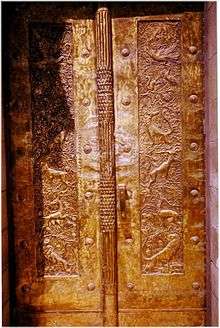
Situated near the religious neighborhoods of Geula and Mea Shearim, Bikur Holim admits a very high percentage of Haredi Jews, and tries to cater to their needs. Shabbat is strictly observed. Non-Jewish employees record medical information and answer telephones on the Sabbath. Food is warmed in ovens operated by a timer, in keeping with Orthodox religious rulings.[5]
Architecture
The current building was designed by architect Zvi Joseph Barsky in the neo-classical style with modernist elements. Zeev Raban of Bezalel designed the bronze doors.[9] When Arcady Gaydamak bought the hospital for $35 million in 2007, he commissioned plans, designed by the Architect Moti Bodek to build two hospitalization towers alongside the existing historical structure. [10]
Notable physicians
- Naomi Amir, founder and head of the pediatric neurology clinic and day-hospital[11]
- Aron Brand, pediatrics
- Helena Kagan, founder and head of the department of pediatrics
- Hermann Zondek, internal medicine[12]
See also
- Health care in Israel
References
- Gaydamak wants out of Bikur Cholim Hospital
- Turning things around at Bikur Cholim
- "A state of critical condition". Archived from the original on 2012-09-06. Retrieved 2012-04-17.
- ביקור חולים פרושים בירושלים, מחברה לבית חולים
- Bikur Holim Hospital
- Levinson, Jay. "More than a Century Later" (December 2008 edition). Jewish Magazine. Retrieved 23 June 2020.
- "A state of critical condition". Archived from the original on 2012-09-06. Retrieved 2012-04-17.
- "A state of critical condition". Archived from the original on 2012-09-06. Retrieved 2012-04-17.
- "History of Bikur Holim". Archived from the original on 2009-10-17. Retrieved 2009-04-07.
- Reaching new heights, Haaretz
- Moore, Deborah Dash (1 March 2009). "Naomi Amir". Jewish Women: A Comprehensive Historical Encyclopedia. Jewish Women's Archive. Retrieved 10 December 2016.
- Budapest and Jerusalem: The Patai Letters, 1933-1938, Raphael Patai